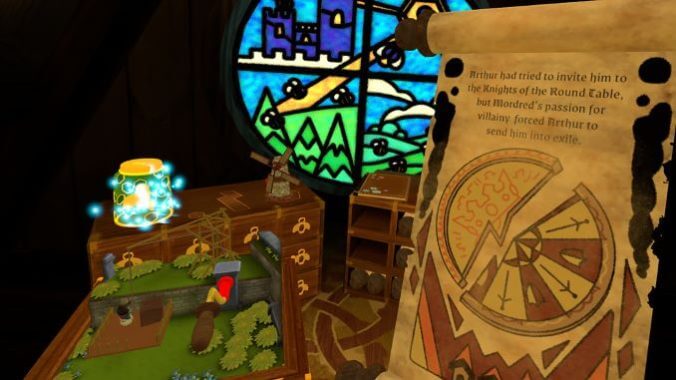A Knight in the Attic Captures the Magic of Childhood in VR

I have the same relationship to VR that I suspect many have: I think it’s a novel piece of tech that we’ve been working towards forever, and to see it come to life is great. However, the reality of the thing is that it is sometimes inaccessible and not always the best way to have experiences. For example, there are precious few games I can conjure when thinking of “VR musts,” and though so many games are retrofitted to fit the burgeoning tech—and they’re often functional—it’s all missing a certain magic. That and one too many VR games feel like a dizzying full body workout. A Knight in the Attic might just be the VR game that found some of that magic for me.
The next game from the team behind The Big Con, itself a charming retro adventure game, A Knight in the Attic finds us going into an attic where we discover a magical labyrinth board. Around it, you see a drawer, a small model of a landscape, a scroll, a jar, a little figurine, and the impressions of other tools you might unlock over the course of the game. Dropping the landscape onto the magical board makes a level appear within its confines, and placing the figurine at the beginning of the labyrinth board allows me to take part in a playable micro-fantasy taking inspiration from the Knights of the Roundtable. It’s a premise that marries the mundane and the fantastical into something cozy and entirely up my alley.
A Knight in the Attic is a simple game, which is the best thing a VR game can be. In my demo, most of the mechanics boiled down to movement and changing the perspective (a la Fez) in order to better see the environments my character was floating through. Movement was almost whimsically floaty, with the little figurine I piloted coasting around the hillside and off of ledges, giddily bobbling the whole time. On occasion, though, my figurine would find something in the environment, like a firefly, which prompted me to break down the walls between my own player character in reality and the fantasy playing it on the board. As silly as I might’ve looked doing it on the PAX showfloor, I reached over to the jar on my left and used it to capture a firefly, before placing it back down on the drawer. I’d pick it back up moments later and bring the jar really close to a gate in the board’s world so that the firefly could unlock the door for me.

A Knight in the Attic
Though I’m sure this is certainly true of plenty of VR games, I really relished how tactile and true to life A Knight in the Attic felt. For example, I could constantly reposition the board in the physical space to best suit me and flit through the pages of a journal that contained secrets I could find through exploration. True to the fantastical nature of the story the game reinterprets, I could unravel a scroll with both my hands to discover more of the backstory. As I played with these toys and this magical world in ways that admittedly felt childish, A Knight in the Attic stirred up memories of warm days spent rifling through old toys in dingy basements or backrooms. It wasn’t transporting me somewhere far flung and out of this world, it was bringing me right back to a childhood where all I wanted was to find the very “magic” A Knight in the Attic was selling me.
I didn’t get to explore the full range of mechanics A Knight in the Attic has to offer, but a glimpse at what the team has shown prominently features a hammer, whose impression I was able to make out on the drawer earlier, allowing players to interact with elements that need hammering in the micro-world. At one point in a trailer, you have to pitch the board sideways in order to use a water source in the fantasy world to fill a pitcher in the real one. Time and time again, the interactions you seem to have in A Knight in the Attic break down that barrier between the real and magical in ways that are increasingly more interesting to me than the fully immersive environments in the blockbuster VR space.
Importantly for me, A Knight in the Attic feels comfortable, and that comfort never feels like artifice. Its art style reminds me of fairy tales read to me while I was growing up. As far as I played, the game doesn’t really ever drop the whimsical tone, either. And again, because it bears repeating, it felt playful, in that way that I’ve rarely been since I was a kid. Not playful in the way I smacked action figures into each other, but in the way that I used to conjure worlds, characters, voices, and absurd plots from nothing but my mind and a handful of figures. And that’s all the motivation I need to someday see A Knight in the Attic through.
Moises Taveras is the assistant games editor for Paste Magazine. He was that one kid who was really excited about Google+ and is still sad about how that turned out.